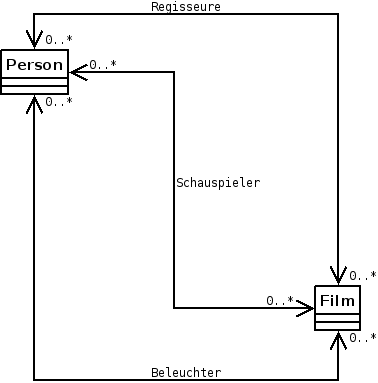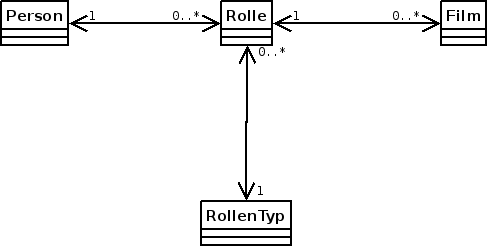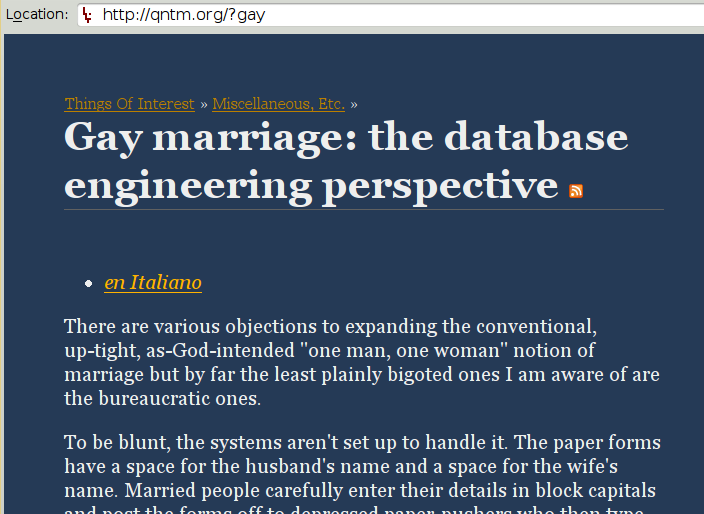Kreative Assoziationen
Beziehungen und Eheprobleme
Michael Schürig
Viele Beziehungen

- Jede Beziehung wird durch eine eigene Verknüpfungstabelle modelliert.
- Für jede neue Beziehung müssen Code und Datenbank geändert werden.
-
Schwierige Fragen:
- Wer ist an diesem Film beteiligt?
- An welchen Filmen ist diese Person beteiligt?
Die eine Beziehung: von der Rolle

- Ternäre Verknüpfung: Person, Film, Typ
-
Manche Queries werden schwieriger:
- Wer war Regisseur dieses Films?
-
Andere werden leicher:
- Wer war an diesem Film beteiligt?
Symmetrie in der Ehe
Ich bin mit dir verheiratet
⇔ Du bist mit mir verheiratet
- Beispiel für eine symmetrische Beziehung.
- Serielle Monogamie: Die Assoziation benötigt Informationen über den Zeitraum.
Schauspielerei
class Movie < ActiveRecord::Base has_and_belongs_to_many :actors, :class_name => 'Person' # ... für Regie, Kamera, Schnitt, Makeup, ... endNein, so nicht.
- Directors Guild of America: erlaubt nur einen Regisseur Wikipedia/DGA.
Rollen!
class Movie < ActiveRecord::Base
has_many :roles
has_many :participants, :through => :roles,
:source => :person
end
class Role < ActiveRecord::Base
validates_presence_of :role_type
belongs_to :person
belongs_to :movie
end
Aber wie bekomme ich (nur) eine Rolle?
movie.participants.find(:all, :conditions => ...)Das tut ja weh.
Erweiterte Assoziationen
class Movie < ActiveRecord::Base
has_many :roles do
def as_actor
self.scoped(
:joins => 'CROSS JOIN roles',
:conditions => { :roles => { :role_type => "actor" } }
)
end
def as_director
...
end
end
has_many :participants, :through => :roles,
:source => :person do
...
end
end
- Wer bin ich?
- self
- AssociationProxy, verhält sich fast wie das Zielobject.
- proxy_owner
- Returns the object the association is part of.
- proxy_reflection
- Returns the reflection object that describes the association.
- proxy_target
- Returns the associated object for belongs_to and has_one, or the collection of associated objects for has_many and has_and_belongs_to_many.
Wiederhole ich mich?
JA!
Dynamisch weniger reden...
class Movie < ActiveRecord::Base
has_many :roles do
def as(role_type)
self.scoped(
:joins => 'CROSS JOIN roles',
:conditions => { :roles => { :role_type => role_type }}
)
end
end
end
...und trotzdem alles sagen
class Movie < ActiveRecord::Base
has_many :roles do
def as(role_type)
...
end
[:actor, :director].each do |role_type|
define_method("as_#{role_type}") do
as(role_type)
end
end
end
end
- Wo kommen denn die Typen her?
Rollen, Schauspieler, Regisseure
Da war noch was:
class Movie < ActiveRecord::Base
has_many :roles do
...
end
has_many :participants, :through => :roles,
:source => :person do
def as(role_type)
...
end
[:actor, :director].each do |role_type|
define_method ...
end
end
end
Muss das sein?
Dürrezeit
Nein.
class Movie < ActiveRecord::Base
has_many :roles, :extend => RoleTypeExtension
has_many :participants, :through => :roles,
:source => :person,
:extend => RoleTypeExtension
end
module RoleTypeExtension
def as(role_type)
...
end
[:actor, :director].each do |role_type|
define_method ...
end
end
- Assoziationen können auch um Module erweitert werden.
- Umso praktischer, wenn die Erweiterungen an mehreren Stellen passen.
Serendipity
class Person < ActiveRecord::Base
has_many :roles, :extend => RoleTypeExtension
has_many :movies, :through => :roles,
:extend => RoleTypeExtension
end
Beschränkte Gruppen
class Person < ActiveRecord::Base
named_scope :actors, {
:joins =>
'INNER JOIN roles ON roles.person_id = people.id',
:conditions => { :roles => { :role_type => 'actor' }
}
end
- Wir können nun die Schauspieler, Regisseure zu einemFilm finden. Wie finden wir alle?
- Ein Schritt zurück, es geht auch ohne Assoziationen
- Aber wir drohen, uns wieder zu wiederholen.
Dynamische Gruppen
class Person < ActiveRecord::Base
['actor', 'director'] do |role_type|
named_scope role_type.pluralize,
{
:joins =>
'INNER JOIN roles ON roles.person_id = people.id',
:conditions => { :roles => { :role_type => role_type }
}
end
end
end
Oops, we did it again
['actor', 'director'] do |role_type|
Jedes Ding an seinem Platz
class Role < ActiveRecord::Base
ROLE_TYPES = %w(actor director).freeze
def self.each_role_type(&block)
ROLE_TYPES.each(&block)
end
end
class Person < ActiveRecord::Base
Role.each_role_type do |role_type|
named_scope role_type.pluralize,
...
Nur zur Ansicht?
movie.participants.add(... ? ...) movie.participants.remove(... ? ...)
- Bisher können wir nur durch bestehende Verknüpfungen wühlen.
- Neue erzeugen oder alte zerstören können wir nicht
Geben und Nehmen (1)
class Movie < ActiveRecord::Base
has_many :roles, :extend => RoleTypeExtension
has_many :participants, :through => :roles,
:source => :person, :extend => ParticipantsExtension
module ParticipantsExtension
include RoleTypeExtension
...
end
end
module RoleTypeExtension
...
end
Geben und Nehmen (2)
module ParticipantsExtension
include RoleTypeExtension
def add(role_type, person)
proxy_owner.roles.build(
:person => person,
:role_type => role_type)
end
def remove(role_type, person)
role = Role.find(:first,
:joins => :roles,
:conditions => {
:person_id => person,
:movie_id => proxy_owner,
:role_type => role_type })
proxy_owner.roles.delete(role)
end
end
- Tückisch: Änderungen sind nicht unmittelbar an den assoziierten Objekten sichtbar!
Besuch im Kontrollraum
class MoviesController < ApplicationController
def create
@movie = Movie.new(params[:movie])
respond_to do |format|
...
end
end
def update
@movie = Movie.find(params[:id])
@movie.update_attributes(params[:movie])
respond_to do |format|
...
end
end
end
- Wenn wir einen neuen Film anlegen, dann wollen wir natürlich gleichzeitig Schauspieler und Regisseur zuordnen. Ebenso wenn wir einen Film aktualisieren.
- "Beteiligung" an einem Film ist keine eigenständige Ressource.
- Filme und die daran hängenden Beteiligten bilden ein Aggregat mit dem Film als Wurzel.
Immer zu Diensten
Was der Client schickt:
{
"id" => 4217,
"movie" => {
"title" => "Tramping Along the Rails",
"actor_ids" => ["1", "2", "3", "5", "8"],
"director_ids" => ["13"]
}
}
Komplizierter Kunde
Ein Auftrag mit Sonderwünschen:
{
"id" => 4217,
"movie" => {
"title" => "Tramping Along the Rails",
"actors" => [
{ "person_id" => "1", "credited_as" => "Will Shatter",
"character" => "Captain Krak" }
{ "person_id" => "7", "credited_as" => "Lemur Nerode",
"character" => "Mr Conehead" }
],
...
}
}
Waren wir (ich) zu schlau?
-
Movie#actorsist der Abstraktion zum Opfer gefallen. - Es würde die Request Parameter ohnehin nicht verstehen.
Bahnarbeiter
Wir überreden den Kunden, uns die Daten in dieser Form zu liefern
{
"id" => 4217,
"movie" => {
"title" => "Tramping Along the Rails",
"roles_attributes" => [
{ "id" => "1", "credited_as" => "Will Shatter",
"character" => "Captain Krak", "role_type" => "actor" }
{ "id" => "13", "_delete" => "1" }
],
...
}
}
Arbeitserleichterung
Dann nimmt Rails uns die weitere Arbeit ab.class Movie < ActiveRecord::Base has_many :roles, :extend => RoleTypeExtension accepts_nested_attributes_for :roles, :allow_destroy => true end
- Transaktionssicher
- Nachteil: Zwingt den Models eine sehr spezifische externe Daten-Repräsentation auf.
-
fields_for - Nested Attributes
- Autosave Associations
Pause
Ehevertrag
- Ich bin mit dir verheiratet und du mit mir
- Dein ist mein ganzes Herz
- ...aber vielleicht nicht für immer
- Ich habe eine Vergangenheit — und eine Zukunft
Asymmetrie
"Ach, wir sind verheiratet?"class Person < ActiveRecord::Base has_many :marriages has_many :spouses, :through => :marriages, :source => :spouse end class Marriage < ActiveRecord::Base belongs_to :person belongs_to :spouse, :class_name => 'Person' end ich.marriages.create(:spouse => du) du.spouses == ?
- Unbrauchbar für Assoziationen und Queries.
Polygamie
class Person < ActiveRecord::Base
has_and_belongs_to_many :marriages
def spouses
marriages.map(&:people).flatten - [self]
end
end
class Marriage < ActiveRecord::Base
has_and_belongs_to_many :people
end
ich.marriages.create(:spouse => du)
ich.spouses.include?(du) # => true
du.spouses.include?(ich) # => true
du.marriages.create(:spouse => no3)
...
- Problem: Wie wird die richtige Anzahl der Ehepartner garantiert?
- Möglichkeit: Locking (optimistisch/pessimistisch) des Marriage-Objekts.
-
Kompliziert:
has_many :spouses, :through => :marriagesnicht möglich
Inkonsistenz
class Person < ActiveRecord::Base
has_many :marriages
has_many :spouses, :through => :marriages, :source => :spouse
end
class Marriage < ActiveRecord::Base
validates_presence_of :start_date
belongs_to :person
belongs_to :spouse, :class_name => 'Person'
after_create { |m| Marriage.create(:person => m.spouse,
:spouse => m.person) }
after_destroy { |m| Marriage.delete_all(:conditions => ...) }
end
- Redundanz macht Inkonsistenz möglich.
Spieglein, Spieglein
create_table :marriages_internal do |t|
t.belongs_to :person1, :null => false
t.belongs_to :person2, :null => false
end
add_index :marriages_internal, [:person1_id, :person2_id],
:unique => true
create_view :marriages,
%{SELECT id, person1_id, person2_id FROM marriages_internal
UNION
SELECT id, person2_id, person1_id FROM marriages_internal
} do |v|
v.column :id
v.column :person_id
v.column :spouse_id
end
http://github.com/aeden/rails_sql_views
-
Fehlende Attribute:
start_date,end_date,lock_version.
Mit Klasse
class Marriage < ActiveRecord::Base belongs_to :person belongs_to :spouse, :class_name => 'Person' validates_presence_of :person, :spouse end class Person < ActiveRecord::Base has_one :marriage, :conditions => 'end_date IS NULL' has_one :spouse, :through => :marriage end
-
Die Tabelle (View) marriages enthält Zeilen mit doppelten
ids, aber ActiveRecord merkt davon nichts. -
validates_presence_of: ja, das ist (inzwischen) richtig so. Früher mußte der Foreign Key angegeben werden, heute ist (auch?) die Assoziation selbst korrekt.
Regeln für eine gute Beziehung
CREATE RULE
- Der View verhindert keine gespiegelten Duplikate
-
Der View kennt nur
SELECT -
SELECT,INSERT,UPDATE,DELETE:
Statements werden mit Produktionsregeln umgeschrieben - PostgreSQL-spezifisch
-
Nicht vergessen:
config.active_record.schema_format = :sql
-
Regeln per
executein der Migration ausführen. -
MySQL kann nicht mit
UNIONin Updatable Views umgehen. - Statement Trigger mit BEFORE/AFTER genügen nicht.
Regeln (1): Hochzeit
CREATE RULE marriages_ins AS ON INSERT TO marriages DO INSTEAD
INSERT INTO marriages_internal (person1_id, person2_id,
start_date, end_date)
VALUES (LEAST(NEW.person_id, NEW.spouse_id),
GREATEST(NEW.person_id, NEW.spouse_id))
RETURNING id, person1_id, person2_id, start_date, end_date;
-
IDs der Ehepartner in kanonischer Reihenfolge:
person1_id<person2_id. -
RETURNING: Sicht auf die eingefügte Zeile; ActiveRecord nimmt davon nurid. -
Reduziert:
lock_versionfehlt.
Regeln (2): Scheidung
CREATE RULE marriages_upd AS ON UPDATE TO marriages DO INSTEAD
UPDATE marriages_internal
SET start_date = NEW.start_date,
end_date = NEW.end_date
WHERE (id = OLD.id);
Regeln (3): Vergessen
CREATE RULE marriages_del AS ON DELETE TO marriages DO INSTEAD DELETE FROM marriages_internal WHERE (id = OLD.id);
Drum prüfe...
class Marriage < ActiveRecord::Base
def before_validation
self.start_date ||= Date.today
end
def validate_on_create
errors.add_to_base("...") if person == spouse
end
def validate
if end_date && end_date < start_date
errors.add(:end_date, "...")
end
validate_unmarried(person, :person_id)
validate_unmarried(spouse, :spouse_id)
end
...
und prüfe...
...
def period
today = Date.today
((start_date || today)..(end_date || today))
end
def overlaps?(other_period)
period.overlaps?(other_period)
end
def validate_unmarried(person, attribute)
others = person.marriages.during(period) - [self]
unless others.empty?
errors.add(attribute, "Is already married at that time.")
end
end
end
Mit Hilfe
class Person
has_many :marriages do
def during(dates)
self.select { |marriage| marriage.overlaps?(dates) }
end
end
end
-
Kein DB-Zugriff mit
#exists?. Diemarriage-Assoziation wird früher oder später ohnehin geladen.
Heiratsschwindel
| Prozess1 | Prozess2 |
|---|---|
|
|
|
|
validate | |
validate | |
save | |
save |
- TOCTTOU
- Transaktionen allein helfen nicht!
Serialisierte Monogamie (pessimistisch)
So:
class Marriage < ActiveRecord::Base
def before_validation
...
Person.find(:all,
:conditions => { :id => [person, spouse].compact },
:lock => true)
end
end
Nicht:
def before_validation
...
person.try(:lock!)
spouse.try(:lock!) # There be deadlocks
end
-
#compact, weilperson/spousenilsein können. -
Einzeln
#lock!genügen nicht: Gefahr eines Deadlocks. - Die Personen wirken als Mutex für ihre angehängten Ehen.
-
ActiveRecord#lock!
Serialisierte Monogamie (optimistisch)
class Marriage < ActiveRecord::Base belongs_to :person, :touch => true belongs_to :spouse, :class_name => 'Person', :touch => true end
-
ActiveRecord::StaleObjectError: Attempted to update a stale object - Kein Deadlock, weil keine blockierenden Operationen vorkommen
- Derzeit noch nicht in Gems, nur in Git, branch 2-3-stable
Pause
Brad - Jennifer - Angelina
date = movie.release_date movie.participants.select do |brad| jennifer = brad.marriages.ended_before(date).last.spouse angelina = brad.marriages.started_after(date).first.spouse jennifer && angelina && movie.participants.include?(angelina) end
- Lustig, aber ineffizient.
- Für Ernstfälle besser in SQL schreiben.
Archiwurfentierung?
War das jetzt
- Architektur?
- Design?
- Implementierung?
- Ja!
Architektur: Wo — Controller
- Der Controller ist dumm
- Controller sind sich sehr ähnlich
- Fassade vor einem Ausschnitt der Domäne
- REST: Repräsentant einer Ressource
- Übersetzer für Anfragen und Antworten
- evtl. mit Hilfe von (Rack) Middleware
Architektur: Wo — Model
- Kennt sich aus in seinem Fachgebiet
- Zuständig für Dinge und ihre Zusammenhänge
- DDD: Aggregat(wurzel)
Design: Was
- Filme
- Personen
- Schauspieler
- Regisseure
- Ehepartner
- ...
- Objekte und ihre Rollen
Implementierung: Wie
has_many, ...named_scope, ...CREATE VIEWCREATE RULE
Das war's
Mehr über mich und von mir:
http://www.schuerig.de/michael
Zum Nachschauen:
http://www.schuerig.de/michael/pres/kreative-assoziationen/
